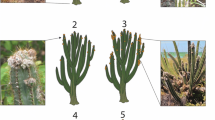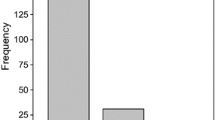Abstract
The alien forb Campuloclinium macrocephalum (Less.) DC. (Asteraceae, pompom weed) invades disturbed rangelands in South Africa. After >40 years of naturalisation, infestations around Pretoria were severely damaged in 2006 by the biotrophic rust Puccinia eupatorii Dietel (Pucciniaceae). The disease spread rapidly and has now established at most pompom weed infestations in the country. This study reports on the efficacy of the pathogen as a biocontrol agent of pompom weed, its effect on the retention of the weed’s realised niche and tolerance to the disease. Eighty rangeland infestations originally assessed over two years in 2003 and 2004 were re-surveyed in 2009. Data from untreated plots at two pompom weed experimental sites where the rust was first detected were also used. Puccinia eupatorii induced premature senescence in late summer and stimulated the production of compensatory growth in autumn. Plants without disease symptoms senesced in late autumn without compensatory growth and remained dormant throughout winter. Pompom weed density did not change significantly over time in both the rangeland study and untreated plots. Disease incidence in rangelands in 2009 was most severe in dense infestations, with sparse infestations having the highest incidence of natural senescence and fewer pustules. The rust did not reduce the realised niche; infestations in grasslands, savanna and wetlands persisted despite significant damage by the disease. Persistence, despite high annual stem mortality, suggests that pompom weed remains adapted to the fungus after prolonged separation from the disease. This study supports earlier findings that disturbance remains key to pompom weed invasion even under biological control. The rust may enhance the biological control of pompom weed with augmentation of additional insect agents, but is unlikely to inflict a significant reduction in the weed’s population on its own. This may be an important consideration for the biological control of weeds involving biotrophic fungi.





Similar content being viewed by others
References
Berger S, Sinha AK, Roitsch T (2007) Plant physiology meets phytopathology: plant primary metabolism and plant–pathogen interactions. J Exp Bot 58:4019–4026. doi:10.1093/jxb/erm298
Cade BS, Richards JD (2005) User manual for Blossom statistical software. Fort Collins Science Center, US Geological Survey, Fort Collins
Cade BS, Terrell JW, Schroeder RL (1999) Estimating effects of limiting factors with regression quantiles. Ecology 80:311–323
Callaway RM, Ridenour WM (2004) Novel weapons: invasive success and the evolution of increased competitive ability. Front Ecol Environ 2:436–443
Catford JA, Jansson R, Nilsson C (2008) Reducing redundancy in invasion ecology by integrating hypotheses into a single theoretical framework. Divers Distrib 15:22–40. doi:10.1111/j.1472-4642.2008.00521.x
Clay K, van der Putten W (1999) Pathogens and plant life histories. In: Vuorisalo T, Mutikainen P (eds) Life history evolution in plants. Kluwer, Dordrecht, pp 275–302
Colautti RI, Ricciardi A, Grigorovich IA, MacIsaac HJ (2004) Is invasion success explained by the enemy release hypothesis? Ecol Lett 7:721–733
Cummins GB (1978) Rust fungi on legumes and composites in North America. University of Arizona Press, Tucson
Deacon JW (1997) Modern mycology. Blackwell Scientific, Oxford
Denoth M, Frid L, Myers JH (2002) Multiple agents in biological control: improving the odds? Biol Control 24:20–30. doi:10.1016/S1049-9644(02)00002-6
Dhileepan K, Florentine SK, Lockett CJ (2006) Establishment, initial impact and persistence of parthenium summer rust Puccinia melampodii in north Queensland. In: Preston C, Watts JH, Crossman ND (eds) Proceedings of the 15th Australian weeds conference. Weed Management Society of South Australia Inc., Adelaide, pp 577–580
Evans HC (2008) The endophyte-enemy release hypothesis: implications for classical biological control and plant invasions. In: Julien MH, Sforza R, Bon MC, Evans HC, Hatcher PE, Hinz HL, Rector BG (eds) Proceedings of the XII international symposium on biological control of weeds. CAB International, Wallingford, pp 20–25
Fauchereau N, Trzaska S, Rouault M, Richard Y (2003) Rainfall variability and changes in Southern Africa during the 20th century in the global warming context. Nat Hazards 29:139–154
Friedli J, Bacher S (2001) Mutualistic interaction between a weevil and a rust fungus, two parasites of the weed Cirsium arvense. Oecologia 129:571–576. doi:10.1007/s004420100763
Goodall J, Witkowski ETF, Ammann S, Reinhardt C (2010) Does allelopathy explain the invasiveness of Campuloclinium macrocephalum (pompom weed) in the South African grassland biome? Biol Invasions 12:3497–3512. doi:10.1007/s10530-010-9747-2
Goodall J, Witkowski ETF, Morris CD, Henderson L (2011) Are environmental factors important facilitators of pompom weed (Campuloclinium macrocephalum) invasion in South African rangelands? Biol Invasions 13:2217–2231. doi:10.1007/s10530-011-0035-6
Hatcher PE, Paul ND (2000) On integrating molecular and ecological studies of plant resistance: variety of mechanisms and breadth of antagonists. J Ecol 88:702–706
Hatcher PE, Paul ND (2001) Plant pathogen–herbivore interactions and their effects on weeds. In: Jeger MJ, Spence NJ (eds) Biotic interactions in plant–pathogen associations. CABI International, Wallingford, pp 193–225
Henderson L, Goodall J, McConnachie A, Klein H (2010) Pompom weed (Campuloclinium macrocephalum): growth conditions and “weedy” nature. Agricultural Research Council. http://www.arc.agric.za/home.asp?pid=4536. Accessed 4 May 2011
Joshi J, Vrieling K (2005) The enemy release and EICA hypothesis revisited: incorporating the fundamental difference between specialist and generalist herbivores. Ecol Lett 8:704–714
Juenger T, Bergelson J (2000) The evolution of compensation to herbivory in Scarlet Gilia, Ipomopsis aggregata: herbivore-imposed natural selection and the quantitative genetics of tolerance. Evolution 54:764–777
Keane RM, Crawley MJ (2002) Exotic plant invasions and the enemy release hypothesis. Trends Ecol Evol 17:164–170
Klimešová J, Kociánová A, Martínková J (2008) Weeds that can do both tricks: vegetative versus generative regeneration of the short-lived root-sprouting herbs Rorippa palustris and Barbarea vulgaris. Weed Res 48:131–135
Kluth S, Kruess A, Tscharntke T (2003) Influence of mechanical cutting and pathogen application on the performance and nutrient storage of Cirsium arvense. J Appl Ecol 40:334–343
Kruess A (2002) Indirect interaction between a fungal plant pathogen and a herbivorous beetle of the weed Cirsium arvense. Oecologia 130:563–569. doi:10.1007/s00442-001-0829-9
Marais R (2004) A plant ecological study of the Rietvlei Nature Reserve, Gauteng Province. MSc Thesis, University of the Free State, Bloemfontein
McConnachie AJ, Retief E, Henderson L, McKay F (2011) The initiation of a biological control programme against pompom weed, Campuloclinium macrocephalum (Less.) DC. (Asteraceae), in South Africa. In: Moran VC, Hoffmann JH, Hill MP (eds) Biological control of invasive alien plants in South Africa (1999–2010). African Entomology (Special Issue) 19:258–268
McNaughton SJ (1983) Compensatory plant growth as a response to herbivory. Oikos 40:329–336
Norris RJ, Memmot J, Lovell DJ (2002) The effect of rainfall on the survivorship and establishment of a biocontrol agent. J Appl Ecol 39:226–234
Olckers T, Hill MP (1999) Appendix: releases of introduced biological control agents against weeds in South Africa. In: Olckers T, Hill MP (eds) Biological control of weeds in South Africa (1990–1998). African Entomology, Memoir No. 1, pp 175–182
Paul ND, Ayres PG (1986) The Impact of a pathogen (Puccinia lagenophorae) on populations of groundsel (Senecio vulgaris) overwintering in the field: II. Reproduction. J Ecol 74:1085–1094
Paul ND, Ayres PG (1987) Survival, growth and reproduction of groundsel (Senecio vulgaris) infected by rust (Puccinia lagenophorae) in the field during summer. J Ecol 75:61–71
Roy BA, Kirchner JW (2000) Evolutionary dynamics of pathogen resistance and tolerance. Evolution 54:51–63
Thaphathi V, Manyaga K, Mugwedi L, Goodall J (2007) Herbicide effect on seed viability of Pompom (Campuloclinium macrocephalum). In: Proceedings of the 42nd annual congress of the Grassland Society of Southern Africa, 16–20 July, Rhodes University, Grahamstown
van der Meijden E, Wijn M, Verkaar HJ (1988) Defence and regrowth, alternative plant strategies in the struggle against herbivores. Oikos 51:355–363
Weiher E, van der Werf A, Thompson K, Roderick M, Garnier E, Eriksson O (1999) Challenging Theophrastus: a common core list of plant traits for functional ecology. J Veg Sci 10:609–620
Acknowledgments
We thank the Gauteng Department of Agriculture, Conservation and Environment for funding this study from 2003 to 2005 and the KwaZulu-Natal Department of Agriculture, Environmental Affairs and Rural Development from 2009. Linde du Toit, Lutendo Mugwedi and Khumbudzo Manyaga are thanked for their assistance with field surveys. We are also grateful to pathologists Dr. Alan Wood and Ms. Estianne Retief for their insight and perspectives on pathogens as biocontrol agents and Puccinia species in particular. Our thanks and appreciation is extended to the journal-appointed reviewers, whose advice has greatly improved the quality of this manuscript.
Author information
Authors and Affiliations
Corresponding author
Rights and permissions
About this article
Cite this article
Goodall, J., Witkowski, E.T.F., McConnachie, A.J. et al. Altered growth, population structure and realised niche of the weed Campuloclinium macrocephalum (Asteraceae) after exposure to the naturalised rust Puccinia eupatorii (Pucciniaceae). Biol Invasions 14, 1947–1962 (2012). https://doi.org/10.1007/s10530-012-0205-1
Received:
Accepted:
Published:
Issue Date:
DOI: https://doi.org/10.1007/s10530-012-0205-1




